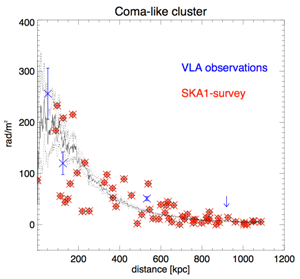Jun 16 2014
At the Advancing Astrophysics with the Square Kilometre Array conference held in June 8-13 in Giardini Naxos, Italy, scientists presented new modelling showing the game-changing capability the SKA will bring to the field of cosmic magnetism. The conference brings together more than 250 scientists from around the world presenting results in fields as diverse as cosmology, exobiology, pulsars or cosmic magnetism.
 Number of sources detected in the background of a galaxy clusters at increasing distance from the cluster centre. Blue points are the current measures obtained from VLA observations, red crosses represent the forecast for SKA1-survey.
Number of sources detected in the background of a galaxy clusters at increasing distance from the cluster centre. Blue points are the current measures obtained from VLA observations, red crosses represent the forecast for SKA1-survey.
Magnetism is ubiquitous in our Universe, with interstellar gas, planets, stars and galaxies all showing the presence of magnetic fields, but it is poorly understood. While stars and galaxies can be seen directly by the light they emit, magnetic fields are invisible even to the largest optical telescopes, instead requiring the detection of polarised radiation, radiation which exhibits the effects of magnetic fields, visible at radio wavelength. Moreover, astronomers currently do not understand the processes that power these magnetic fields over such long lifetimes.
Cosmic magnetism in large-scale structures with SKA
Dr Annalisa Bonafede from the Hamburg Observatory presented her work showing how the SKA will allow a much more in-depth study of cosmic magnetic fields in large-scale structures.
To understand the immense magnetic fields powered by galaxy clusters – large groups of hundreds or thousands of galaxies – scientists search for background radio sources, such as galaxies, located further away and “behind” the cluster as seen from Earth. As the radio waves emitted by these background sources travel towards Earth and through the cluster, they are affected by the large-scale magnetic field of the cluster.
“The more radio sources identified behind the cluster, the better the constraint on the magnetic field’s properties” explains Dr Bonafede. “With today’s telescopes however, only a handful of radio sources can been detected behind clusters, the reason being the others are too far and too faint and would require too much observation time.”
When the SKA survey instrument is up and running in Australia in the early 2020’s, Dr Bonafede predicts it will allow to improve detection of background sources by a factor of 10 at least, providing astronomers with much better data on the magnetic field’s properties.
What’s more, because of its increased sensitivity, Dr Bonafede explains the SKA will allow to see variations of intensity within the magnetic field itself, which are the telltale signs of massive events having affected the cluster, such as the merger of two galaxy clusters. Until now, this has only been attempted a couple of times and been partially successful.
You can read more on cosmic magnetism here. https://www.skatelescope.org/science/magnetism/
Contact details [email protected]
Ultra deep-field observations with SKA and cosmic magnetism
Dr Russ Taylor from the University of Cape Town presented his work on conducting deep field observations with the SKA1-MID dishes (to be located in South Africa) to detect the radio emissions from distant galaxies.
Active distant galaxies experiencing strong bursts of star-formation emit strong emissions detectable at radio wavelengths.
Deep-field observations, made famous through the images from the Hubble Space Telescope, require long observation times to detect the faint signals from extremely faraway galaxies. These images revealed a huge quantity of faint faraway galaxies in multiple directions, strengthening the belief that the Universe is uniform over large scales and that the Earth occupies a typical region in the Universe (This is known as the cosmological principle).
Until now, the deepest such images ever made at radio wavelengths were done with NRAO’s Very Large Array in the USA, and revealed some 500 galaxies within a 0.1 degree area, up to a redshift of 0.3.
Dr Taylor expects the SKA will be able to detect the emissions from some 100,000 galaxies over an area of 10 square degrees, “an increase by a factor of 100 compared to current observations done with other telescopes” he says. “Additionally, he adds, thanks to the SKA’s sensitivity, we’ll be able to detect the emissions from galaxies up to a redshift of 3 or 4, which has never been achieved until now”.
With a much larger sample to work on, the SKA observations are expected to bring a treasure trove of new data on galactic magnetic fields, ultimately leading to a better understanding of the emergence and evolution of cosmic magnetic fields and star formation over cosmological time.
Contact details [email protected]